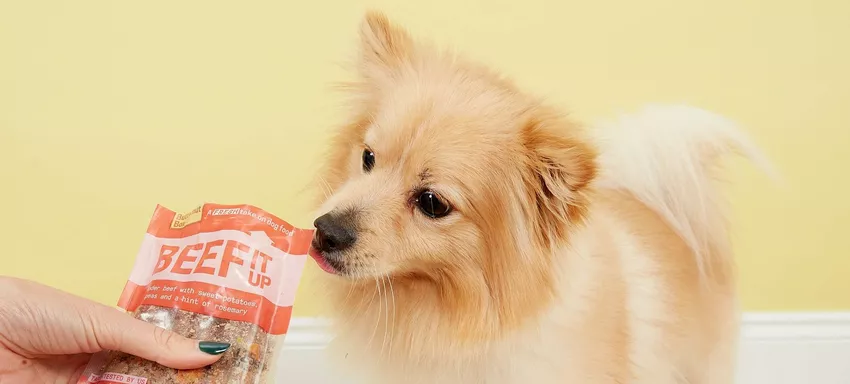How to Change Dog Food
- 21 Dec 2019
- 7m read

Have you been feeding your pup their favourite food and they've suddenly decided they no longer like it? Or maybe they've become a little chubby lately and you'd like to give them healthier chow. They might have even developed an illness that requires a different diet.
Reasons for changing a dog’s diet might vary, but there's only one way to make the switch. A sudden change can lead to tummy upsets, so a slow, steady and gradual transition is the gentlest way to go.
Top Reasons for Switching Dog Food
There are a number of reasons why you may be considering changing your dog's food, the most common reasons are:
Lifestage
Graduation from a pup to a pooch means that your dog will require a different quantity and type of food. Now that they’re fully grown, it’s less about building healthy bodies and more about maintaining them. Typically adult dogs will be able to exercise for longer and will be sleeping less, meaning that they will need bigger, more nutrient-dense meals.
Similarly, senior pooches require a different diet. Typically as your dog gets older they start to favour shorter, less-intense walks which end with a well-deserved afternoon nap. Because of this, their nutritional needs change, they no longer need as many calories to sustain them.
But, paws for thought, it’s not all about quantity here. Different ingredients start to play a bigger role as dogs get older. Diets rich in certain herbs and spices become more important as the frequent old age ailment begins to set in. Turmeric, for example, is a really helpful ingredient in senior dog food as it helps to promote healthy joint health and reduce pain
Boredom
Imagine soup season has rolled around and you make batches big enough to feed 5,000. A few days in, it begins to lose novelty. Your furry friend isn’t so different. If they’re turning their nose up at food and not eating, it’s likely that they’re no longer satisfied with what they’re being given.
Instead, opt for a food brand that has plenty of recipes to choose from. This gives you a much better chance of ensuring that your fussy pup will lick the bowl clean.
Food intolerances
Gone are the days when dogs had to forage for their own food. It’s likely that your pooch’s ancestors would eat whatever they could get their paws on, which was most likely smaller prey, not al fresco pasta.
It makes sense then that our dogs are pre-conditioned to thrive on a diet that is as close to this as possible, and why other ingredients, such as wheat, might disagree with them. Common signs of food intolerance include: vomiting, diarrhoea, flatulence (excuse you), itchy red skin, hair loss and ear infections. So if your furry pal is experiencing any of these symptoms it might be time to switch up their food.
New health condition
Diagnosis of a new health condition is likely to mean that your pooch’s diet will have to be revisited. Dogs with pancreatitis for example, will have to be fed low-fat, easily-digestible food. This is to prevent the pancreas from being overworked, as this can cause nasty symptom flare-ups. Highly processed food should also be avoided as this often causes more aggravation.
Weight
It can be difficult to gauge exactly what the perfect weight is for your dog. Chances are, if your pooch has a pouch it’s time to think about changing up their diet and shift some of the excess weight. Alternatively, your dog could be underweight and need some help building themselves up.
Either way, diet plays a huge part in weight maintenance so it’s really important to make sure you are feeding them quality nutrition at the right quantities. Pet MD suggests consulting your vet to determine the best diet for your dog.
The Best Way to Change Dog Food in 3 Easy Steps
If you're transitioning, it’s good to remember that not all dog foods are nutritionally equal. If you’re moving from commercial food to a high-quality complete option, portion sizes will be different. That’s because lower-quality foods tend to be packed out with fillers so pooches need to eat more to get enough nutrients.
1. Gradually mix the new food with the old
We can’t stress how impawtant it is to change your dog's food gradually. Their sensitive tums can’t handle quick switches in food any more than humans can handle extra hot spice. We’ve come up with a really helpful guide so you know exactly what quantities to introduce day by day.
2. Monitor changes in your dog’s health and behaviour
Changes in diet can sometimes reveal food intolerances and allergies that you might not have been aware of previously. These include sensitivity to wheat, milk and even some meats. Some allergies can cause your pooch to break out in hives or lose hair. If you see these symptoms start to alleviate when swapping to a new food, it is likely that their previous diet was causing this.
Keep an eye on how your dog’s general well-being develops as you switch foods. Are they happier? Do they have more energy? Are they scratching their skin less? Is their poop less runny?
3. Make a final decision
After you’ve successfully transitioned over to the new food it’s time to make a decision. Is this new food benefitting your pooch? If the answer is yes then it deserves a big round of appaws. If not, then it might be time to start the process over again with a new type of food. If this is the case, make sure that you follow the same process to ensure that your dog doesn’t suffer from any unwanted side effects.
Signs That You’ve Changed Dog Food Too Quickly
The PDSA recommends that you introduce any new food over a couple of weeks, rather than all at once. And there are a few reasons why.
Runny poos
Keep an eye on your pup's poop (never mind what the neighbour's think) to make sure the transition is going smoothly. Dogs require a regular, balanced diet to live a happy life, and an unexpected change in what they're eating can knock things out of whack. It can result in all sorts of nasty misfortunes, from treacherous farts to stomach aches and diarrhoea.
Our poop-tastic guide is here to help. If your dog is falling in the region of lovely log and soft sausage, you’re safe. Anything else and we wish you all the luck in the world…but also advise that you slow the transition process down.
Vomiting
Moving on from the rear end. If your pooch is being sick it’s likely because something just isn’t agreeing with them. This can be avoided by changing food more gradually. Monitor the volume closely, a vet should be consulted if the problem persists. Making sure that your dog has access to plenty of fresh water and cuddles should help them feel better.
Transitioning Your Dog Food to Butternut Box
When you sign up with us, we understand it’s going to be a change for your dog and that it needs to be slow. First of all, we ask you for the low-down on your dog – from their age to their breed, state of health and body condition. We do this so our clever algorithm can work out the correct daily calorie intake and the perfect portion size for your pup. We then start you off with a 14-day trial box to get your four-legged family member on board with our drool-worthy meals.
Happily, Butternut Box meals contain no nasties and are hypoallergenic, as well as being nutritionally complete. For that reason, we expect any allergies to clear up when you make the swap. We've worked with expert nutritionists and our experienced in-house Vet to make sure our meals are easy to digest and kind to sensitive tums. For extra belt-and-braces, every ingredient is sourced from trusted, quality farmers. We use delicious ingredients like veg, human-quality meat, lentils, herbs, vitamins and minerals in each doglicious pouch.
We even ask pet parents for poo feedback and almost two-thirds have reported an improvement in poo quality compared to their previous diets. We’re very poop-ular.
In case you have questions, with your first delivery, we include a handy guide full of advice on how to mix things up and introduce our meals to your dog's diet.
So, keep it slow and steady, pet parents – think tortoise, not hare.

.webp)


